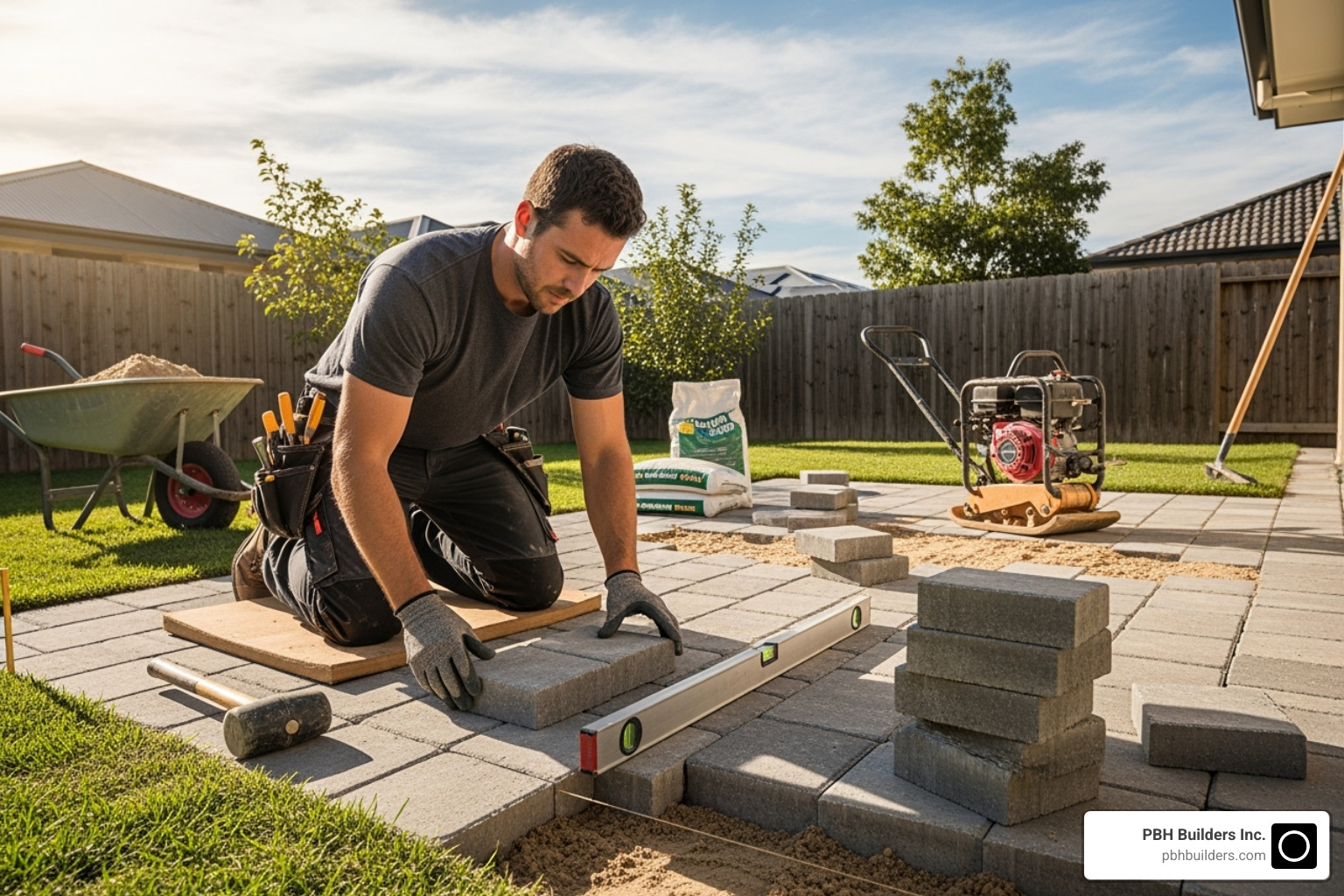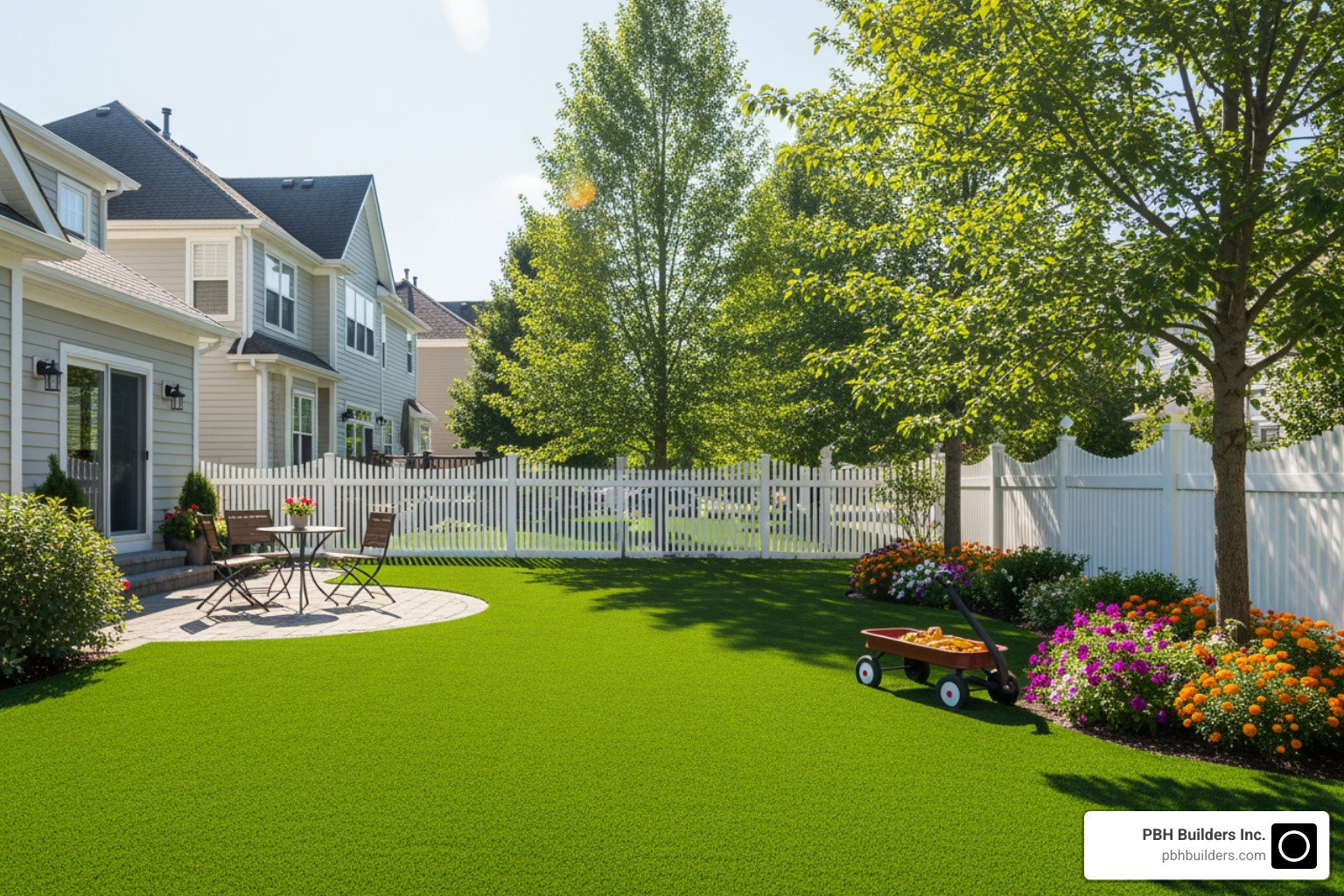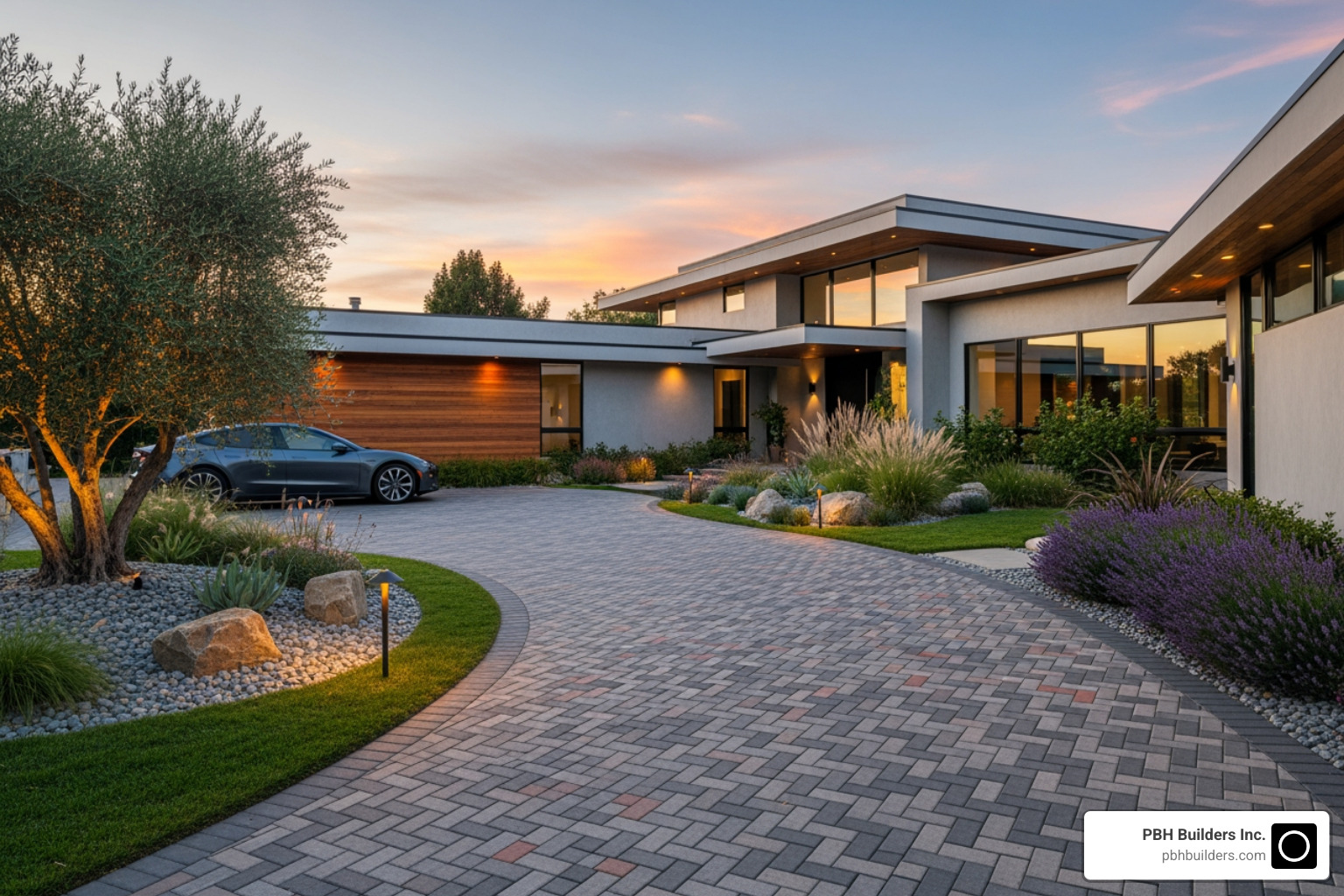Why Professional Paver Installation Transforms Your Outdoor Living Space
Finding the right patio paver contractor is crucial for creating a beautiful, durable outdoor space that adds value to your San Diego home. A qualified contractor brings expertise in material selection, proper installation, and design to ensure your project will last for decades.
Quick Guide to Hiring a Patio Paver Contractor:
- Look for ICPI certification – Industry standard for paver installation expertise
- Verify licensing and insurance – Protects you from liability and ensures professional standards
- Check customer testimonials and photo portfolios – Proof of quality workmanship
- Ask about warranties – Reputable contractors offer 2-year workmanship guarantees
- Get detailed estimates – Compare materials, labor, and project timelines
- Confirm local experience – San Diego’s climate requires specific installation knowledge
The paving stone market is growing, reflecting homeowners’ preference for pavers due to their superior durability and aesthetic appeal over poured concrete.
Pavers are rated 4 times stronger than poured concrete (8000 psi vs 2000 psi) and resist cracking from soil movement and temperature changes. They are designed to withstand all weather conditions while maintaining their beauty for years.
Your outdoor space is a significant investment. Whether you envision a cozy patio or an expansive entertaining area, the right contractor will guide you through material, design, and installation choices to create lasting results.
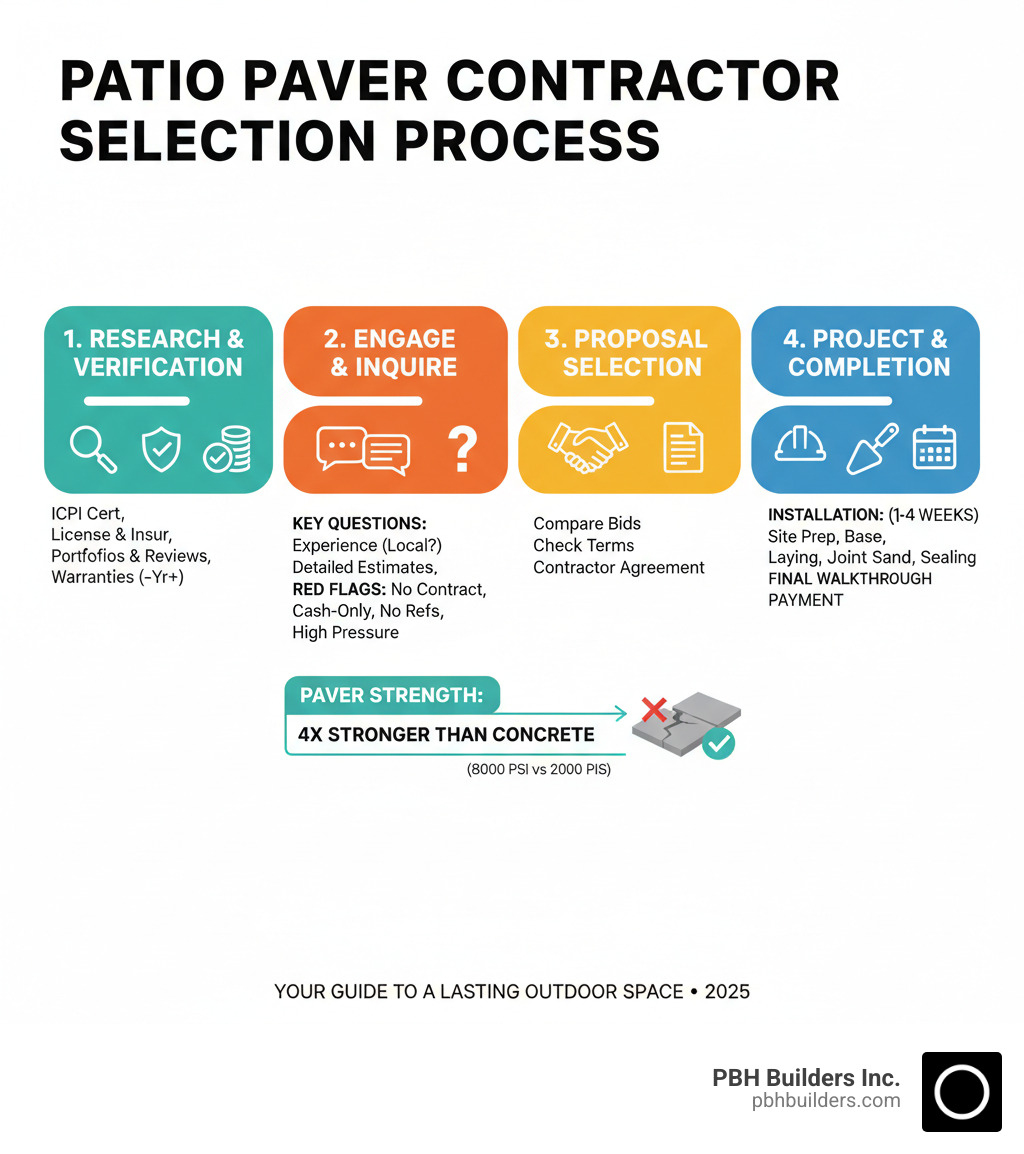
Why Pavers are a Superior Choice for Your Outdoor Space
For an outdoor space that stays beautiful for decades, pavers are a smart choice for San Diego homeowners. They offer best durability and aesthetic versatility, complementing any home style from modern to traditional. Installing pavers can also significantly boost your property value, making it a smart financial decision. The secret to their performance is interlocking technology, which creates a flexible, crack-resistant surface that moves with the ground, unlike rigid poured concrete. Pavers are an excellent choice for low maintenance landscaping that delivers lasting beauty.
Pavers vs. Poured Concrete and Natural Stone
Choosing the right material can be overwhelming. Here’s how pavers stack up against poured concrete and natural stone:
| Feature | Pavers | Poured Concrete | Natural Stone |
|---|---|---|---|
| Durability | Extremely resistant, rated 8000 psi, interlocking allows movement, rarely cracks. | Prone to cracking due to expansion/contraction, rated 2000 psi. | Highly durable, but can chip or crack under heavy impact. |
| Cost | Higher initial cost, but lower long-term maintenance/repair. | Lower initial cost, but higher long-term repair frequency. | Highest initial cost, varies greatly by stone type. |
| Repairability | Individual pieces easily replaceable. | Difficult to repair seamlessly; often requires full slab replacement. | Individual pieces can be replaced, but color/texture matching can be challenging. |
| Design Options | Vast assortment of colors, shapes, patterns, textures. | Limited to stamping/staining for patterns, fewer color options. | Unique natural variations, but limited by stone’s inherent form. |
Pavers truly shine in strength. Rated at an impressive 8000 psi, they are four times stronger than typical poured concrete (2000 psi), easily handling heavy traffic and furniture. Their key advantage is cracking resistance. The joints between pavers allow the surface to flex with ground movement, preventing the large cracks common in rigid concrete. This design flexibility, combined with a vast selection of colors and patterns, is something concrete can’t match. Plus, if a paver is ever damaged, you can replace a single piece—a simple fix compared to repairing a cracked concrete slab.
The Long-Term Value: Durability and Maintenance
A paver installation is a long-term asset. Quality pavers can last for decades with proper installation and minimal care, often backed by manufacturer lifetime guarantees.
Simple repairs are a key benefit. If a paver is damaged, a skilled patio paver contractor can replace the individual piece seamlessly. Maintenance is straightforward: regular sweeping and occasional rinsing are usually sufficient. For tougher stains, specialized cleaners are available.
Sealing pavers every few years improves color, protects against stains, and inhibits weed growth. Their flexible joint system also provides superior resistance to freeze-thaw cycles, preventing the damage that often affects concrete. For more inspiration, explore our guide to beautiful outdoor spaces.
Exploring Your Paver Options: Materials, Styles, and Designs
Choosing the right pavers sets the tone for your entire outdoor space. Today’s market offers an incredible array of materials, colors, and textures to complement any San Diego home, from timeless brick to modern porcelain. A qualified patio paver contractor helps you balance visual appeal with practical factors like climate and use. The goal is to harmonize color and texture with your home’s architecture for a seamless transition. Our Landscape Design team specializes in creating these cohesive outdoor living spaces.
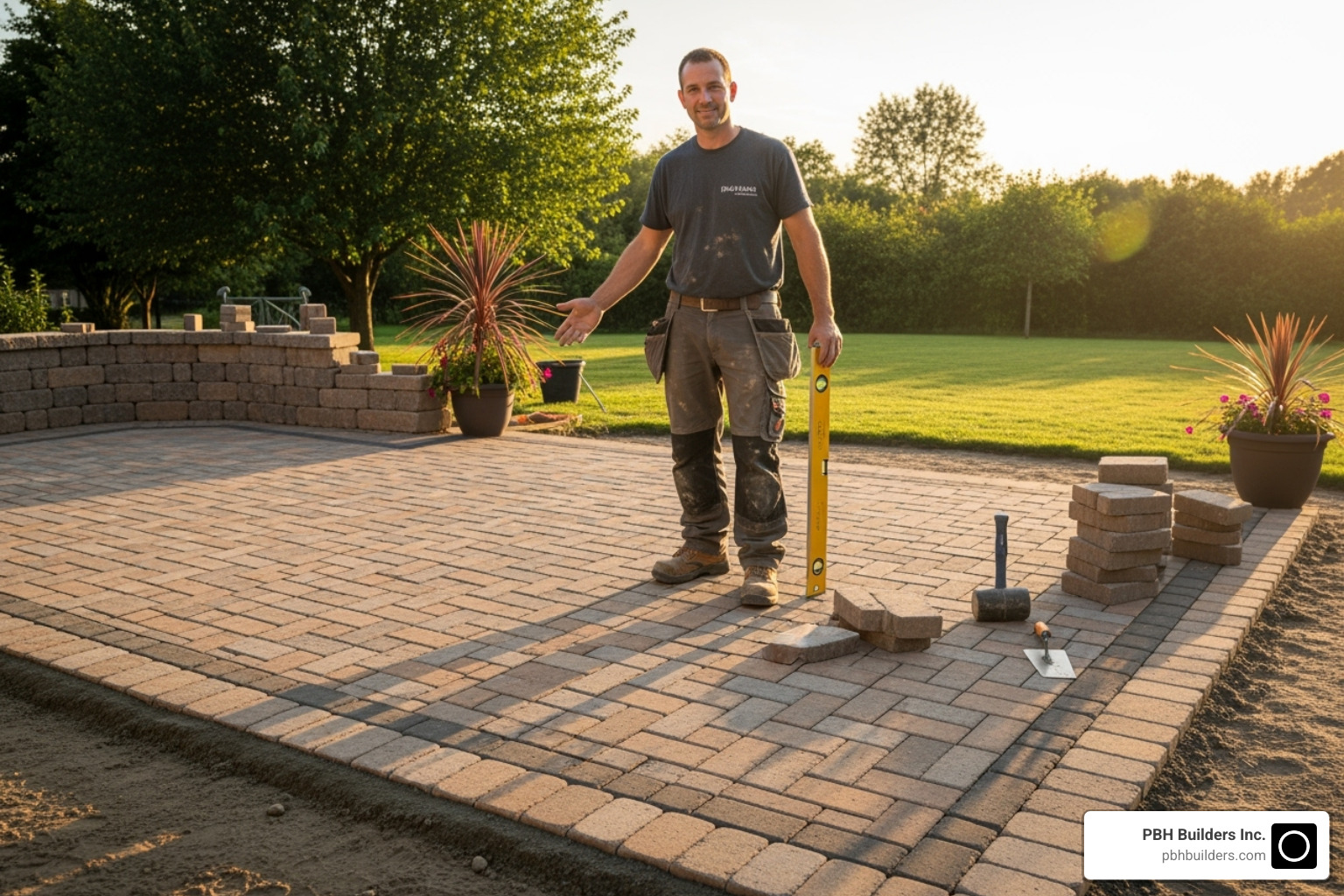
Types of Paving Stones and Their Characteristics
- Concrete pavers: The most popular choice, offering maximum design flexibility and strength (8000 psi) at a reasonable cost. Their interlocking design prevents cracking.
- Brick pavers: Offer timeless, eco-friendly charm with warm, earthy tones that develop a beautiful patina over time.
- Porcelain pavers: A modern, low-maintenance option with exceptional resistance to stains, fading, and frost. Available in sleek stone and wood finishes.
- Natural stone: Options like flagstone and travertine provide unique, organic beauty for a premium, one-of-a-kind installation.
- Eco-friendly permeable pavers: An environmentally responsible choice that allows rainwater to filter into the ground, reducing runoff.
- Recycled materials: Includes options like recycled rubber pavers, which are great for pool decks or play areas.
Popular Paver Patterns and Modern Design Trends
The pattern you choose can completely transform the character of your outdoor space.
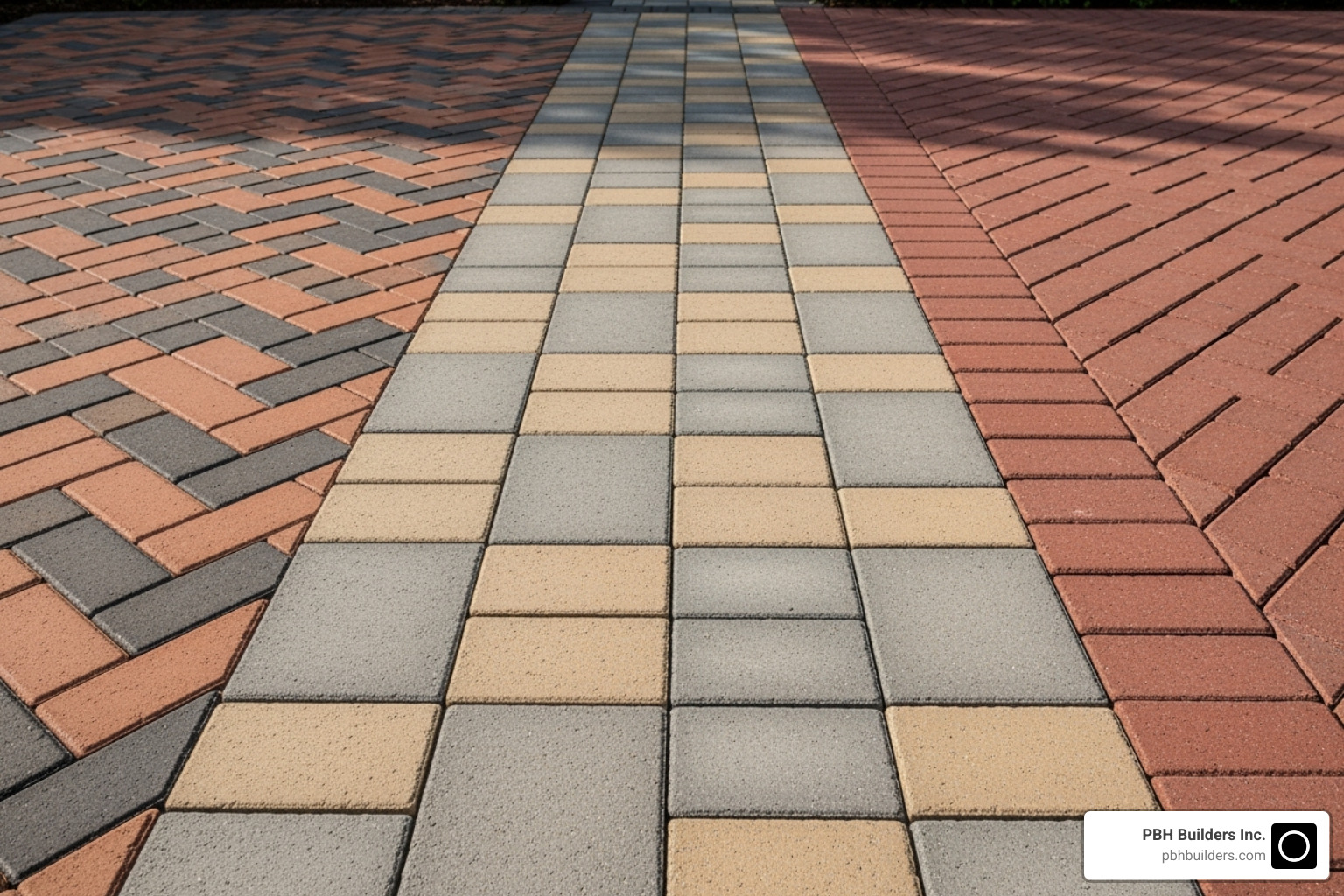
- Herringbone patterns: A classic zigzag design that offers excellent strength, ideal for high-traffic areas and driveways.
- Basketweave patterns: Alternating pairs of pavers create a charming, traditional look perfect for cottage-style settings.
- Running bond patterns: Clean, contemporary lines similar to brickwork, versatile for many applications.
- Random patterns: Using multiple paver sizes creates a natural, organic look that blends well with gardens.
Modern design trends are embracing large format pavers for a minimalist feel and geometric shapes like hexagons for artistic focal points. Borders and accents in contrasting colors or styles provide a polished, professional finish that separates professional installations from amateur attempts. Explore more ideas in our guide to Outdoor Living Spaces.
The Professional Paver Installation Process
While a DIY paver project is tempting, professional installation is both an art and a science. Installing concrete pavers requires specialized tools and expertise to avoid common DIY pitfalls like sinking pavers, poor drainage, and uneven surfaces. Hiring experienced patio paver contractors is the smart choice. We manage every step with precision, from initial drainage planning to final cleanup, ensuring your investment lasts for decades.
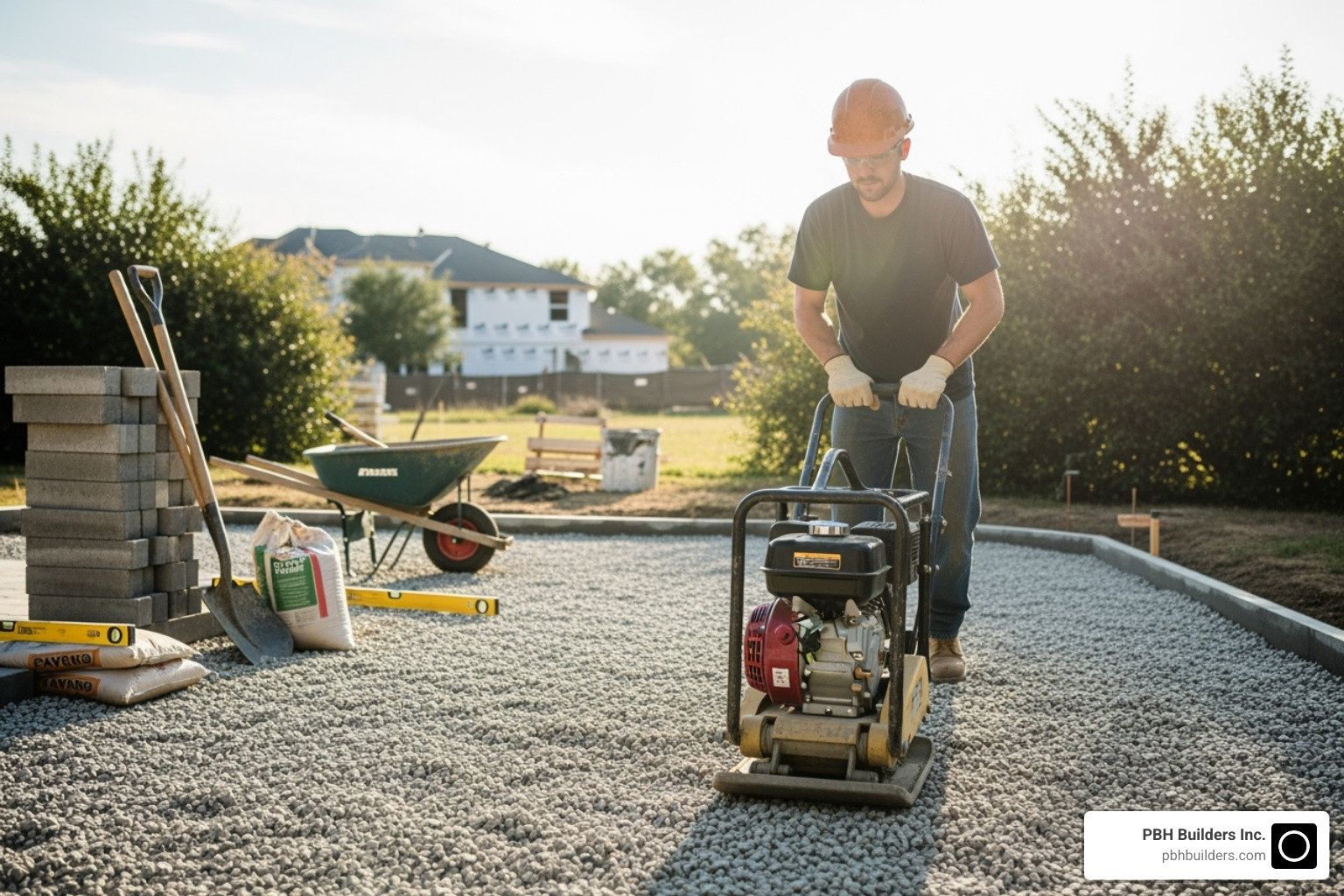
For a deeper understanding of the work involved, check out our guide on How to Choose and Install Pavers for Your Home.
The Critical Role of Excavation and Base Preparation
The foundation is the most critical part of a paver installation, as a poor base guarantees failure. The process involves:
- Excavation: We dig to the proper depth (typically 9 inches), remove soil and debris, and compact the subgrade. For San Diego’s clay soils, we may install a geosynthetic fabric for stability.
- Base Layer: We install and compact Class 2 road base. This is typically 4 inches for patios, 6 inches for driveways, and 8 inches for areas with heavy vehicles.
- Sand Bedding: A 1-inch layer of sharp sand is spread over the base to create a level setting bed for the pavers.
- Edge Restraints: Robust restraints are installed around the perimeter to prevent pavers from shifting over time.
- Drainage Slope: The entire base is graded with a proper slope (approx. 1/4 inch per foot) to ensure water flows away from your home.
For projects needing additional stabilization, we also offer professional Retaining Walls services.
Factors That Influence Project Cost
Several variables influence the cost of a paver project:
- Square footage and paver material: Larger areas and premium materials (like natural stone or porcelain) increase costs.
- Site accessibility: Difficult access can increase labor costs.
- Design complexity: Intricate patterns and custom features require more time and precision.
- Demolition: Removing existing surfaces like old concrete adds to the scope and cost.
- Project location: Permit requirements in areas like Poway can affect the final price.
While the initial investment may be higher than for concrete, pavers offer superior long-term value through durability and lower maintenance.
Hiring the Right Patio Paver Contractor
Finding the right patio paver contractor is key to bringing your outdoor dreams to life. Rushing this decision can lead to costly repairs, so a thorough vetting process is your best protection. A skilled contractor combines technical expertise with attention to detail, changing good materials into an extraordinary space. Pay close attention to their credentials, portfolio, and communication skills. For broader insights, check our guide on Best General Contractors San Diego.
What to Look for in a Contractor’s Credentials and Experience
When evaluating contractors, look for these key indicators:
- Years of Experience: Seasoned contractors understand San Diego’s climate and have refined their techniques.
- ICPI Certification: This is the industry’s gold standard, proving expertise in proper installation and best practices.
- License and Insurance: Always verify their state license and insurance coverage to protect yourself from liability.
- Customer Testimonials: Read detailed reviews on sites like our Testimonials page to understand the client experience.
- Photo Portfolio: A strong portfolio showcases consistent quality, clean lines, and projects similar to your vision.
For additional guidance, Houzz offers valuable insights in their guide on How to hire a contractor.
What to Ask a Potential Patio Paver Contractor
During your consultation, ask these crucial questions:
- Can you provide a detailed, itemized estimate and a clear project timeline?
- What are your warranty details for both workmanship (typically 2 years) and materials?
- What is the payment schedule? (Be wary of contractors demanding large upfront payments).
- Do you use subcontractors, and are they also licensed and insured?
- Is debris removal and site cleanup included in the estimate?
- How do you handle unexpected issues or project changes?
- Can you provide references from recent clients?
A professional contractor will welcome these questions and provide clear answers. If someone seems evasive, that’s a signal to keep looking.
Frequently Asked Questions about Paver Patios
When considering a paver patio, it’s natural to have questions. As an experienced patio paver contractor, we’ve answered the most common ones for San Diego homeowners.
How long do patio pavers last?
With proper professional installation, a paver patio can last for several decades—often 30 years or more. Their durability comes from their resistance to weather conditions and their flexible, interlocking design. Unlike rigid concrete, individual pavers can move independently, preventing the large-scale cracking that occurs from ground shifts. This design, often backed by manufacturer lifetime guarantees, means that if a paver is damaged, it can be replaced individually, giving the patio an almost indefinite lifespan.
Can you lay pavers directly on dirt?
No, you should never lay pavers directly on dirt for a permanent installation. Dirt is not a stable base and will lead to sinking, shifting, and uneven surfaces, creating tripping hazards. It also causes poor drainage, which can lead to erosion and water damage. A lasting paver patio requires proper excavation and base preparation, including a compacted aggregate base and a sand setting bed. This foundation is essential for a patio that lasts for decades instead of failing in a few years.
How do you maintain a paver patio?
Maintaining a paver patio is surprisingly easy.
- Routine Cleaning: Regular sweeping and occasional rinsing with a garden hose are usually all that’s needed. Address spills quickly to prevent stains.
- Weed Control: Proper installation minimizes weeds, but any that appear can be pulled by hand or treated.
- Resanding and Sealing: Every 3-5 years, replenish the joint sand and apply a quality sealer. Sealing protects against stains, inhibits weed growth, and improves the pavers’ color, keeping your patio looking fresh.
Conclusion
A paver patio is an investment in your home’s value and your family’s enjoyment. As we’ve covered, pavers offer superior durability, aesthetic versatility, and long-term value. However, the key to open uping these benefits is professional installation. A proper base and meticulous technique are essential for a patio that lasts for decades.
Choosing the right patio paver contractor—one with ICPI certification, proper licensing, and a strong portfolio—is the most important step in protecting your investment and bringing your vision to life.
Here in San Diego, PBH Builders Inc. combines expert landscape design with precision hardscaping to create outdoor spaces that improve your lifestyle and property value. Professional paver installation transforms your dream patio into a lasting reality.
Ready to see what’s possible? Take a moment to explore our completed projects and find the quality craftsmanship that sets us apart.
